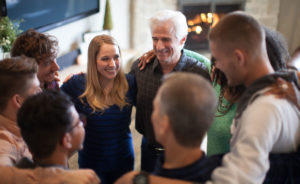Stop Losing Volunteers with This One Activity You Can Start Today
The number one issue, frustration, and challenge that’s facing ministry leaders today is volunteers and the real problem is having enough volunteers, not just how do you lead volunteers or how do you train them.
Although, that’s a challenge. Trust me, I know, but keeping them on your team and getting them on your team are two really big challenges. How do you keep your volunteers?
Most ministry leaders think they just need to recruit better and to keep their team numbers up. The problem with that is that if you have really great recruitment but people are leaving your team, then you’re eventually going to run out of people in your church to recruit and you’re going to start getting into that begging mode, which is really not a good place to be as a ministry leader.
Solve Volunteer Churn First
Really, the first challenge you want to solve is the problem of people leaving your team or people quitting…what we call volunteer churn. Volunteer churn is a huge ministry problem that most ministry leaders either ignore or think they don’t have a problem with. Almost every ministry leader I’ve ever talked to has a problem, has a challenge with people leaving their team.
Now people leave their team for lots of reasons. People leave their team because they are burnt out, because they have life issues going on, because they disagree with the direction of the team, because of conflict on the team. Lots of reasons to leave a volunteer team, but there’s one really big reason why people stay on a team. That reason is connectedness.
Develop Greater Connectedness
That’s also why connectedness is one of the five health markers we teach in the lead up framework. Connectedness is a huge factor in why people feel like they can stay on a team even if there’s life issues, even if they don’t agree with the direction or even if there’s conflict on the team. Connectedness is the thing that makes your team sticky.
Now, there’s one thing you can do right now to make your team more sticky, to make your team members more connected to one another and to you, and that is to spend time with them one-on-one, having conversations with them.
Spending time with your people is the number one thing you can do right now. Like literally today, you can call somebody or text them and put it on your calendar for this afternoon or for tomorrow morning and you can go to them and spend time with them and start building relationships and start developing that stickiness on your team.
Side Effects of Spending Time with Your People
When you spend time with your people, you might find that there are some surprising side effects. Number one is you’re going to have to adjust your schedule to make time for spending one-on-one time with people. That means that your schedule is going to be less office time, less organizing time, less writing time or prepping or research or whatever it is and more time spent with people. Your calendar is going to shift up a little bit.
You’re going to have to make some room in your budget, in your ministry budget, for coffee or for a fishing tackle, if you’re going to take people fishing or for gas, if you’re going to drive around town with them or for an extra space in your gym so that you can work out with them. Whatever it is that you’re going to do to spend time with people, you’re going to have to make some room in your ministry budget to be able to spend time with those people.
There are some really great side effects though. Number one is you’re going to get really great feedback from people on your team. When you take the time to spend lots of time and have deep conversation with the people on your team, they’re going to give you really good feedback that you’re not going to get in just a short conversation on a Sunday morning. That good feedback is going to make your ministry better. It’s going to make you a more effective leader, as well as approve the effectiveness of your team.
Number two is you’ll find that the people that you spend time with will have a deeper commitment to your ministry area because of their commitment and their connection to you. That is the stickiness factor of people being on your team, having a connection to their team leader.
Next, you’re going to find that the people you spend time with on your team are going to become better at recruiting their friends to the team. That actually might solve the open door, open front door, problem that you think you might have with recruiting to your team.
Not only does it make your team stickier for the people that are there that you spend time with, it also expresses to those people that there’s opportunities to connect with leaders in the church by joining that volunteer team, which means they invite their friends. That means that kind of solves your recruiting problem.
Finally, you’re going to find that people are going to be growing in their faith. When you spend time talking about Jesus, connecting what they do in their volunteer ministry to their walk with Christ, you’re going to find that people grow. They will become greater and better made disciples because you spend time with them connecting their service to their commitment to Christ.
Five Ways to Connect with Your People Outside the Office
I’m going to give you five ways that you can connect with people one-on-one or in small groups outside of your church office. Your church office is fine, but after a while it gets a little redundant, it’s a little repetitive, a little bit boring for you and probably the other people. It also is a little bit formal.
Here are five ways you can meet with people outside the office. Number one, and my favorite is to take people fishing. I always keep two fishing rods in my truck just in case and I love to bring a friend along and fish and talk and catch up and talk about deep things. Talk about not deep thing, just have a good time fishing.
Number two is I like to invite people over to my house for a meal. My wife loves to make meals for guests and so it’s a great way to be genuine and authentic and invite people into our home. The other great side effect of this is that it shows people hospitality and demonstrates that we want our people to be hospitable to the people that come to our church.
Number three is to go for a walk or maybe even do a workout with a friend or somebody that you want to mentor, somebody that you want to spend time with. I love going for a walk because it gets your heart rate up, it gets endorphins flowing and it’s still a pace that you can have a good conversation without feeling like you’re out of breath all the time. It’s a really great way to connect and be healthy at the same time.
Number four, and this one might be a little bit weird for you, is to just run errands together. Invite somebody to just run to the store with you, or to run to the grocery with you, or to go pick someone up from the airport. It’s a great way to have some alone time in a car and to connect with them without the distractions of all the things going on around you.
Number five, and this one’s a fun one for me, is I like to go paddling with people. I’ve got two cheap paddleboards and a kayak that I can throw in the back of my truck, take to a creek or a Lake or to the ocean. Again, it’s a healthy thing you can do together. It’s quiet, it’s alone, it’s in nature, and it gives you the opportunity to have really good conversations with people without just sitting in the office or sitting in a coffee shop.
Spend time with your volunteers, and I promise you that your team will become more sticky. You will grow in connectedness and start to fill out those five markers from the lead up framework.
Train church volunteers and disciples online, easy.
Use our simple on-demand video training courses to equip volunteers, develop leaders, and teach disciples. Create your own training or use our video library. Our training automation platform makes it simple and fast to get your people ready for ministry.
Other Posts You May Like
All Growth Begins with Self-Awareness
My first year on the YouVersion Bible App team was exciting and challenging. I joined the team to help with partnerships and community-building. Like any new job, the first year came with a learning curve and the need to pick up new skills. I had never been part of a technology team before, so I…
Is Your Leadership Style Helping or Hurting You?
Your leadership style — how you make decisions, connect with and influence others, delegate, handle conflict, cast vision — is shaped by many factors. Your family history and work experience, along with your personality and internal wiring, impact how you think about and “do” leadership today. Leaders we have worked with, for better or worse,…
A Church Is Only As Healthy As Its Team
When you joined the team at your church, what kind of training did you get in the first weeks? Did you have an HR meeting to cover the health insurance and retirement accounts? Did you cover how to submit an expense report or reserve a room on the master calendar? How about how to handle…



